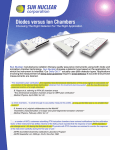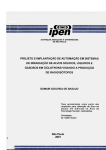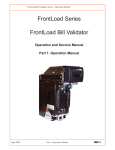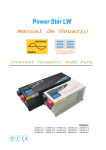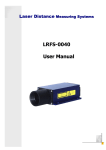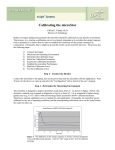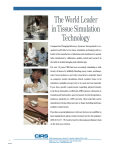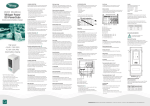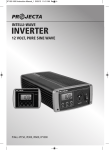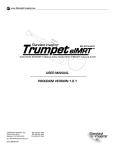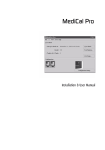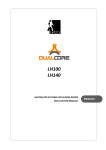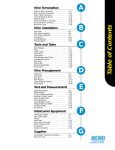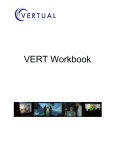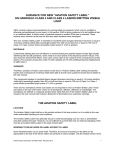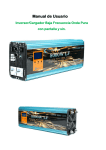Download SunPoint Diode Detectors
Transcript
Benefits Analysis: SunPoint™ Diode Detectors SUN NUCLEAR corporation SunPoint™ PRECISION QA The Right Detector for the Right Application SunPoint™ Diode Detectors The Right Detector for the Right Application™ Sun Nuclear manufactures products using diodes and ion b Sensitivity as a function of dose per pulse. chambers. Both offer unique advantages based on the Unlike other diodes from different manufacturers, the application. Unlike some vendors who insist ion chambers SunPoint Diode Detector sensitivity only changes about are the only acceptable detector for every application, Sun ±1% for 600-fold changes in dose per pulse. Nuclear recognizes that diodes offer benefits that are in Semiconductor diodes can remain linear with dose per the best interest of the patient. For this important reason pulse after very high accumulated dose. 2,5,6 SunPoint Diode Detectors are selected as the dosimeter of choice for many Sun Nuclear products. 3 Stability. SunPoint Diode Detectors have insignificant radiation These benefits include: degradation in short term and long term use. In a short term 1 reproducibility test of 15 consecutive 60 MU measurements, Size. SRS, IMRT, and VMAT deliver small beamlets to avoid response varied ±0.15%. Quantified over a 261 day period of critical structures and hit the target. When millimeters are use, MapCHECK (using SunPoint Diode Detectors) varied ± so critical in the plan and delivery, they are also essential 0.2%. Both studies indicate SunPoint Diode Detector based for measurement accuracy. Measuring only 0.64mm2 and arrays are more stable than ion chamber based arrays. 1,2,4,10 0.000019cm3, SunPoint Diode Detectors are smaller than ion chambers by orders of magnitude, which results in 4 accurate dose plan QA measurements. Ion chambers may SunPoint Diode Detector based instruments do not require be a gold standard for dosimetry calibration; however this warm-up or the application of bias voltage prior to use. Ion is not the case for patient QA. Ion chambers integrate over chamber arrays can require up to 60 minutes and 10Gy a much larger area resulting in a loss of accuracy known prior to use.10,11 Warm-up is a result of the design of the as Dose Volume Averaging. Dose Volume Averaging is instrument. Sun Nuclear’s ion chamber based products do characteristic in ion chambers for small field and gradient not require warm-up but do require bias voltage. Fast Setup. measurement; which is why Sun Nuclear only uses diodes for such applications. 5 Calibration. The calibration for SunPoint Diode Detector products is 2 Sensitivity. very stable. Users typically calibrate every one to three The electron density of silicon is 18,000 times greater than years using Sun Nuclear’s patented 15 minute Wide Field air. Therefore a silicon diode can be thousands of times Calibration14 (WFC) method. WFC affords users an easy, smaller than an ion chamber, while its sensitivity can still accurate, and independent calibration method. WFC is be 10 times higher. The measurement benefit of this is used for ion chamber and diode array products and is a two-fold. First: a higher signal to noise ratio equals better benefit to all Sun Nuclear array product users. Every Sun measurement accuracy and reproducibility. Second: a Nuclear array product receives a factory calibration using smaller detector equals better measurement precision. Ion Sun Nuclear’s in house linear accelerator or Cobalt 60 chambers must always be larger than diodes due to their source. WFC provides the user the ability to calibrate their low sensitivity and signal to noise ratio. Sun Nuclear product with their own Linac, at any time they a Sensitivity as a function of accumulated dose. wish. This allows users to verify the calibration accuracy SunPoint Diode Detectors exhibit consistent sensitivity with themselves, and to perform independent research. The accumulated dose. Sensitivity variation is <0.5%/kGy at accuracy of Sun Nuclear WFC has been clinically proven 6MV, <1.5%/kGy at 10 MeV. The benefit is infrequent array worldwide in thousands of cancer centers. calibration (< once per year) even when detectors receive different accumulated doses. SunPoint™ PRECISION QA 2 Performance specifications of SunPoint Diode Detectors are the best in the industry 6 a Dependencies. 8 Temperature. Absolute dose. Temperature dependence can be compensated by SunPoint Diode Detector based instruments measure the entering a temperature value, or more accurately by absolute dose accurately with the dose calibration of the calibrating dose before measurement. The temperature reference detector to the standard accelerator output, exactly coefficient of SunPoint Diode Detectors remains constant as an ion chamber device would do. with accumulated dose. b 7,9 Pressure. 9 Lifetime. Ion chamber response is dependent on temperature High sensitivity and good stability give SunPoint Diode and pressure, while diode response is only dependent Detectors an extremely long life expectancy. The lifetime on temperature. of Sun Nuclear instrument arrays (ion chamber or SunPoint c Diode Detector based) are a result of changing practices Energy. Energy dependence for SunPoint Diode Detectors and normal electronic and circuit obsolescence and failure. is easily managed with calibration files. For example, Life expectancy is at least ten years under normal use. After 6MV will use a 6MV calibration file; 9MeV will 100 kGy, SunPoint Diode Detector sensitivity is still much use a 9MeV file. higher than that of an ion chamber. d Field size. Ion chambers have field size dependence for small and intensity modulated fields. SunPoint Diode Detectors can be used in all field sizes. The Sun Nuclear EDGE Detector, utilizing a single SunPoint Diode Detector, can be used to scan photon (MV) profiles up to 30 x 30cm, and percent depth dose up to 15 x 15cm. For array products using SunPoint Diode Detectors, such as MapCHECK, calibrate the array at the chosen depth if the field size is greater than 25 x 25 cm and deeper than 10 cm. 2 e SSD and Depth. SunPoint Diode Detector based arrays are proven to accurately measure dose at different SSD’s and depths. MapCHECK IMRT QA depths range from 2-15cm and PROFILER 2 is used at varying depths as a substitute for water phantoms.6 7 Benefits of SunPoint Diode Detectors Smaller Active Area Better Sensitivity Thinner Active Thickness & Volume Less Drift No Dose Volume Averaging n-type and p-type. Diode performance depends on the individual detector, regardless of n-type or p-type. Several publications demonstrate that n-type diodes can perform better than p-type diodes. 2,5,7,8 3 Why chambers are wrong for IMRT, VMAT and stereotactic QA Sophisticated treatments such as VMAT, IMRT and SRS are beam with ionization chambers, gradients will continue to collections of small beamlets with very steep dose gradients be underestimated, hiding a critical dose non-conformity (penumbra) measuring 1 x 1cm or smaller. Because these error. When ion chambers are used for both beam modeling dose gradients are meant to tightly conform to patient anatomy and QA, the planned dose and measured dose may agree and tumor volume, accurate and precise measurement because they BOTH under and/or over estimate dose to the of the dose gradients is of the highest importance. target volume and surrounding structures. The QA results 2 may be favorable, but they are not satisfying the objective of Special care must be taken when comparing planned dose revealing inconsistencies between the conceptual planned to measured dose. If the planned dose is modeled with an dose and actual delivered dose. ion chamber, the dose gradients will be underestimated due to dose volume averaging. If QA is performed on the same Table 1: Comparison of penumbra width of a 2 x 2cm2 field at 1.5cm depth for a 6MV beam13 Manufacturer IBA PTW PTW SunPoint RK PinPoint 0.125 0.8 x 0.8 4.0* 2.0* 5.5* Measured penumbra width (mm) 2.9 4.6 4.1 5.3 Measured flatness (±%) 1.0 4.2 3.4 6.1 Detector Sun Nuclear Active detector size (mm) Figure 1 Figure 2 120 Ion Chamber Diode Film Scanning ion chamber 100 Active volume: > 6000x that of diode 80 60 SunPoint Diode Detector 40 Active volume: 0.000019cm3 20 0 -2 -1 1 0 = Penumbra measured by diode = Penumbra measured by ion chamber 2 Small size = more precision, less averaging 2 x 2cm field profile measurements with various detectors Advantage Table 2: Comparison of active area, volume, and sensitivity13 1 2 3 *Diameter 4 Manufacturer Sun Nuclear IBA PTW Detector array MapCHECK MatriXX 729 0.8 x 0.8 4.5* 5.0 x 5.0 Active area (mm ) 0.64 15.9 25.0 Active thickness (mm2) 0.03 5.9 5.0 0.000019 0.08 0.125 32.0 2.4 3.3 Active dimension (mm) 2 Active volume (cm3) Sensitivity (nC/Gy) SunPoint MatriXX 729 Relative scale size comparison of 2D array detectors. (0.64mm2). Table 1 clearly illustrates that both the 4mm RK chamber (similar in size to the MatriXX detector) and the 5.5mm 0.125 cc chamber (similar in size to the 729 detector) Penumbra over estimation is due to the large size of the chamber. As seen in Table 2, the active detection area of a SunPoint Diode Detector used in Sun Nuclear products is approximately 1/25th the area of a MatriXX detector (15.90mm2), and 1/39th the area of a 729 detector (25.00 mm2). Active Area significantly over estimate the penumbra region by 1.7mm to 2.4mm (59% to 83%). 729 Detector SunPoint The SunPoint Diode Detectors used in Sun Nuclear products measure only 0.8 x 0.8mm MatriXX Detector Diode advantage 1: Smaller active area Diode advantage 2: Thinner active thickness and volume The electrode spacing of the ion chambers in MatriXX and the 729 is more than 150 times could be a 1% difference in beam intensity between the top and bottom of a 5mm thick chamber. The diode is taking a point measurement at exactly the specified depth, the ion chambers are taking an average measurement along a depth range. Thickness larger than the active thickness of the SunPoint Diode Detector. If the SSD is 100cm, there Additionally, the volume of the SunPoint Diode Detector is only 0.000019cm3. This is approximately 4,200 times smaller than a MatriXX chamber, and 6,500 times smaller than a Volume 729 chamber. Diode advantage 3: Better sensitivity The SunPoint Diode Detector has an active volume more than 4,200 times smaller than the ion chambers used in MatriXX and 729, yet its overall sensitivity to radiation is still about 10 times higher. Sensitivity A silicon pn junction diode is about 18,000 times more sensitive than the air cavity ion chamber. Diode Advantage #4 Less Drift and 729. Users typically calibrate SunPoint Diode Detectors only once per year using Sun Nuclear’s patented Wide Field Calibration14. The calibration takes only 15 minutes using the easy-to-follow steps in the SNC Patient software. See Case Study 2 for more details on drift. Drift (±%) The diodes used in Sun Nuclear products have less drift than the detectors used in the MatriXX 5 CASE STUDY 1: Dose modeling The errors in Figure 1(a) are due to the fact that the radiation institution re-modeled their small fields with a 2mm beam that was modeled was not reflective of the actual detector, and when the beam was re-measured with the beam delivered to the MapCHECK. The beam model in (a) MapCHECK, dose map (b) resulted, and the pass rate rose was based on scanning data from a large volume chamber. from 79% to >95%. QA measurements with large chambers If a large chamber is used to collect the beam data for will not reveal these errors; in fact it may hide the error with planning system beam modeling, the result will be planned an erroneously high pass rate, especially if the beam was dose maps that do not accurately portray the actual beam, modeled with a similarly large chamber. and these inaccuracies will not be caught if the plan maps are also verified using large chambers. Diode detectors are small enough to detect these dose volume averaging errors, as demonstrated in (a) below. After determining scenario (a) was unacceptable, this Figure 3: IMRT plan errors detected by MapCHECK (a) Original model 79% passed (6 mm detector) (b) New model >95% passed (2 mm detector) WARNING: Ionization chambers have large measurement volumes and are NOT designed for accurate small field or steep dose ! gradient QA. Small beam models often model dose gradients and beam shape incorrectly. Attempting to discover such errors with ion chambers will extend the measurement error rather than reveal it. CASE STUDY 2: Reproducibility In published reports, short term and long term SunPoint Diode Detectors reproducibility has been shown to be better than ion chamber arrays. Because ion chambers are typically desired for their stability, this is a significant finding and further strengthens the argument for using diode detectors. Short Term Reproducibility Long Term Reproducibility MapCHECK MapCHECK MatriXX 729 6 ± 0.15% (15 consecutive measurements)1 Unknown. Requires 15 minute warmup11 ± 0.50%12 MatriXX 729 ± 0.20% (9 months totaling approximately 50Gy)2 ± 1.30% (7 month period)3 ± 1% (4 month period)4 Frequently asked questions FAQ #1: Do SunPoint Diode Detectors have a high instantaneous dose rate dependence? No. SunPoint Diode Detectors exhibit a sensitivity variation of only ±1% over a 600-fold change in instantaneous dose rate (diode sensitivity change from 75cm to 250cm SSD in an open beam, and also underneath the primary collimator). FAQ #2: Will I have to calibrate the diode array frequently? No. Sun Nuclear uses proprietary radiation hardened diodes. Our diode sensitivity change is less than 0.5% / kGy with a 6 MV beam, and 1.5% / kGy with a 10 MeV beam. A Sun Nuclear user typically calibrates a diode array every 1 to 3 years for a typical patient load. The patented14 array calibration procedure is easily performed in only 15 minutes by the user with a software wizard. There is NO need to send the unit back to the manufacturer for calibration. As seen in Case Study 2, ion chambers could have greater long-term drift than diodes. There are many factors that contribute to detector stability, such as material stability, electronic components, etc. FAQ #3: Can SunPoint Diode Detectors measure in absolute dose? Yes. By following a one-minute calibration routine in the SNC Patient software, the absolute dose calibration factor is obtained for the center diode. By multiplying this absolute dose calibration factor to the array calibration factor of each diode, SunPoint Diode Detectors can measure absolute dose. FAQ #4: What is the lifetime of the SunPoint Diode Detectors? SunPoint Diode Detectors has been in use since 2002 and prototypes are still in clinical use today. SunPoint Diode Detectors have a lifetime of more than 100 kGy, which for most centers will easily equate to more than 10 years. FAQ #5: What happens if one of my diode detectors fail? Diodes rarely fail. It is a misconception that diodes are more likely to fail than chambers. The diode detector is the simplest component on the detector array. If there is a failure, it is almost always a “channel measurement failure” and will most likely be in the measurement electronics, which are common to all array types, including ion chamber arrays. These electronic components are far more complex than a diode detector. Sun Nuclear includes a software feature to turn off a defective channel. This feature will not likely be used due to a defective diode, however it may be used if there is a channel measurement failure. FAQ #6: Is a diode more likely to fail than an ion chamber? No. A user is actually more likely to have an ion chamber failure because the leakage requirements are much more stringent for an ion chamber due to its much lower sensitivity and high voltage. Humidity and microscopic dust will have a much larger impact on ion chambers than on diodes. FAQ #7: Is energy dependence an issue for SunPoint Diode Detectors? No. With MV beams used in IMRT, the response change of the diodes with energy is negligible for the same energy beam. SunPoint Diode Detectors works perfectly if it is calibrated with each energy, taking only about 15 minutes. FAQ #8: What impact will temperature have on SunPoint Diode Detectors? Any changes in temperature in the measurement environment will not be important since the SunPoint Diode Detectors can be calibrated in absolute dose immediately before the measurement session. FAQ #9: Will I get reproducible results with SunPoint Diode Detector based instruments? Yes. Please see the case study on page 6. 7 Document references: 8 “ Diode in vivo Dosimetry for Patients Receiving External Beam Radiation Therapy”, E. Yorke, et al, AAPM Report No. 87 (TG62), Medical Physics Publishing, College Park, MD, 2005. 1 “ Evaluation of a 2D diode array for IMRT quality assurance”, D. Létourneau, et al, Radio. Oncol., 70(2), 199-206 2004 (2004). 2 “A 2-D diode array and analysis software for verification of intensity modulated radiation therapy delivery”, P. A. Jursinic and B.E. Nelms, Med. Phys. 30, 870-879 (2003). 3 “ Dosimetric characterization of a large area pixel-segmented ionization chamber”, S. Amerio, et al, Med Phys, 31(2) 414-420 (2004). 9 “ Accuracy contra work load in In Vivo Dosimetry”, G. Rikner and E. Grusell, Dept of Med Phys, Uni Hosp, Uppsala, Sweden, www.scanditronix-wellhofer.com. 10 “Comparison of two commercial detector arrays for IMRT quality assurance”, Jonathan G. Li,Guanghua Yan,and Chihray Liu, JACMP, Volume 10, Number 2, Spring 2009 4 “ Characterization of a 2D ion chamber array for the verification of radiotherapy treatments”, E. Spezi, et al, Phys. Med. Biol., 50, 3361-3373 (2005). 11 I’mRT MatriXX User Manual 5 “ Modeling the instantaneous dose rate dependence of radiation diode detectors”, J. Shi, W.E. Simon, T.C. Zhu, Med. Phys. 30 (9), 2509-2519 (2003). 12 User Manual 2D Array Seven29 (T10024) Version 1.1 6 “ Performance evaluation of a diode array for enhanced dynamic wedge dosimetry”, T. C. Zhu et al, Med Phys 24, 1173-1180 (1997). 14 US Patent No. 6,125,335 13 Data provided by Ron Watts, Ph.D. 7 “ Dose rate and SSD dependence of commercially available diode detectors”, AJ S. Saini and T. C. Zhu, Med. Phys., 31 (4), 914-924 (2004). Clinical testimony “For domestic plan verification, the expected two-dimensional distribution of the array signals is calculated via convolution of the planned dose distribution, obtained from the treatment planning system, with two-dimensional response function of a single chamber.” B. Poppe et al, referring to PTW 2D chamber arrays “Two dimensional ionization chamber arrays for IMRT plan verification” Medical Physics, April 2006, Vol. 33 (a 4mm chamber)...”is small enough to accurately measure the profile, as long as the field size is not smaller than 4x4cm2” S. Amerio et al, original collaborators to the MatriXX “Dosimetric characterization of a larger area pixel-segmented ionization chamber” Medical Physics, February, 2004, Vol. 31 SunPoint Diode Detectors SUN NUCLEAR corporation Your Most Valuable QA and Dosimetry Tools SunPointW11032011 The Right Detector for the Right Application Corporate Headquarters 425A Pineda Court Melbourne, Florida 32940 tel: + 1 321 259-6862 web: www.sunnuclear.com








